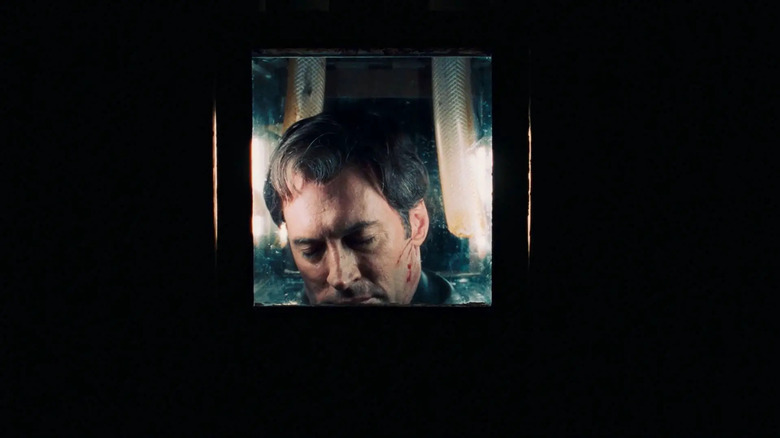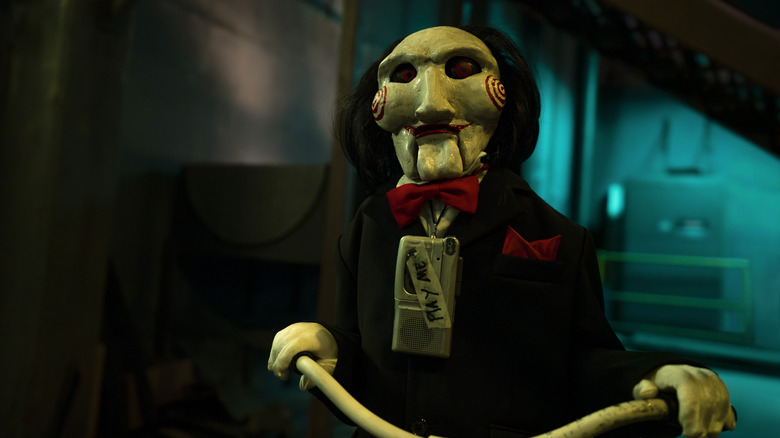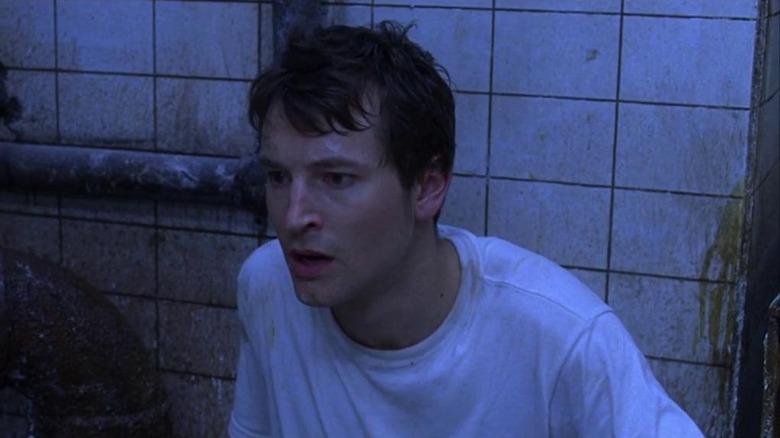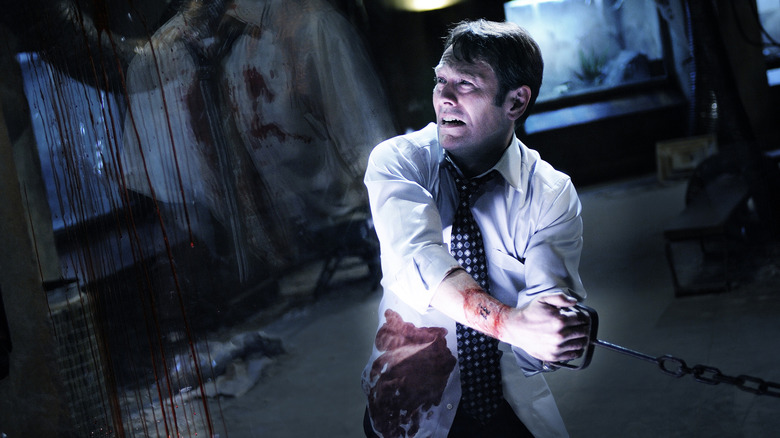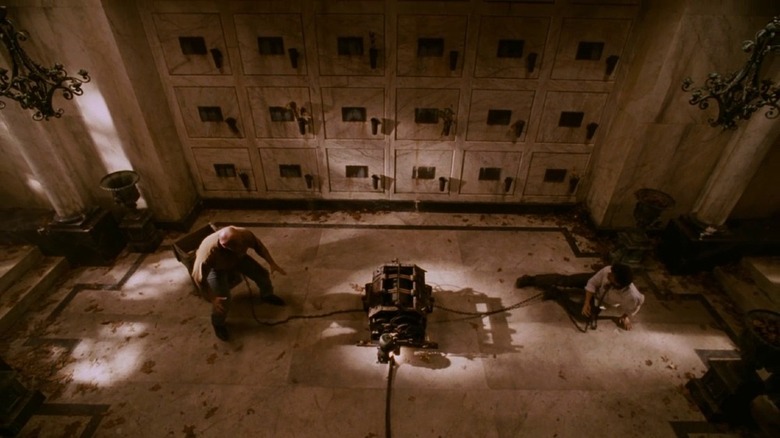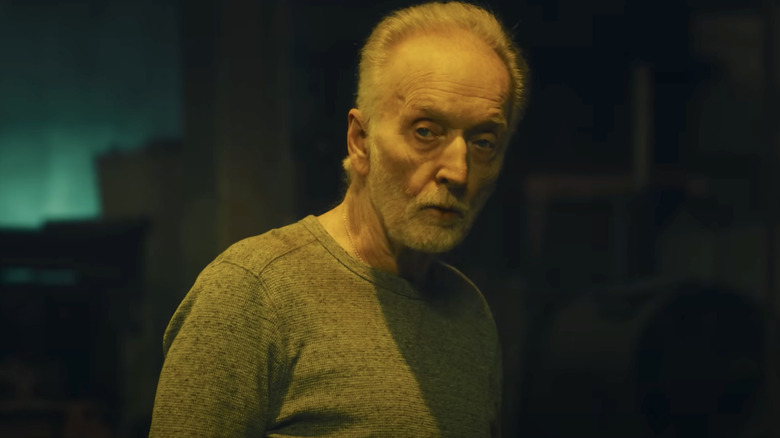The Saw Series Was Never 'Torture Porn' And It's Time To Retire That Term Forever
On February 6, 2006 — just a little over three months after the release of "Saw II" — critic David Edelstein published an op-ed in New York Magazine entitled "Now Playing at Your Local Multiplex: Torture Porn." It's one of those catch-all "state of the cinema" pieces that critics, journalists, and other culture commentators love to write every so often, attempting to point out a media trend as it's happening; I myself have written several such pieces during my career.
Sometimes these articles are thoughtful observations on what the medium is doing and where it may be heading. Sadly, more often than not, they act as glorified dog whistles, seeking to stir up controversy and public opinion against the oh-so-scary New Thing We Don't Like. As such, it almost doesn't matter that Edelstein spends the bulk of the piece attempting to reconcile with post-9/11 horror films, gliding over and seemingly missing the point of the movies and the genre itself entirely — his work is all done for him thanks to that attention-grabbing headline, featuring a term that (allegedly) he coined: "torture porn."
That term was applied to a number of horror movies released during the '00s, but it especially stuck to the "Saw" franchise. The series became a target thanks to it pulling a hat trick of no-nos: the films were incredible financial successes, the franchise was put on a rigid "one every year" schedule, and the movies dared to be intelligent with a strong moral center (thereby offending the critics who believe horror should be brainless and disposable).
One might hope that such disparaging labels would hold little sway in 2023, but unfortunately, Owen Gleiberman's review of this month's "Saw X" in Variety begins by saying, "The 'Saw' films have always been rightfully tagged as torture porn," with the headline derisively crowing that "Saw X" "Comes Closer to Being a Real Movie." What Mr. Edelstein and Mr. Gleiberman fail to realize is that the "Saw" films are not and never were mere "torture porn," and anyone still calling them that is a big ol' dum-dum.
Ghettoizing horror
The ghettoization of horror is nothing new, as the genre tends to muddle through waxing and waning periods of cultural respectability. In the United States, it's no surprise that horror films, when criticized en masse, tend to be looked at through a puritanical lens. Because American cinema was generally put under censorship with the enforcement of the Hays Code in 1934, the moral hysteria surrounding horror films' content was more or less muted during the time of the Code's reign. Instead, horror and science-fiction movies were dismissed as lighter fare, being labeled as lowbrow and made for little money, to be shown after more prestigious feature films. Hence the term "B movie," to be played after an A feature.
Still, there were certainly periods of incensed anti-horror campaigns, and not just against horror films; it's important to remember that psychiatrist Fredric Wertham's anti-comic book screed "Seduction of the Innocent" from 1954 was heavily inspired by publisher EC Comics' various horror-themed titles. As American media began to become more permissive (hand in glove with rapidly changing social and cultural mores), Hollywood films started to strain against the Code; infamously, Alfred Hitchcock's "Psycho," one of the first slasher films, broke new ground by showing something as innocuous as a flushing toilet.
Prior to the '00s "torture porn" craze, the largest anti-horror campaign occurred in the late '70s-early '80s, a good decade after the Code fell and boundary-pushing became de rigueur. The slasher made a pop culture splash from about 1979-1982, which saw Hollywood chasing cash thanks to the runaway success of 1978's "Halloween." The proliferation of movies with a focus on elaborate (and, yes, gory) kill scenes so offended the establishment that many critics couldn't see the forest for the trees, and any intelligence, depth, or craft in them was routinely ignored in favor of moral outrage. Gene Siskel and Roger Ebert were famously a couple of the worst offenders in this regard, going so far as to publicly insult filmmakers and (in Siskel's case) print addresses for the public to harass.
Don't confuse art with ballyhoo
One major wrinkle when it comes to the generally off-base and outrageous slams against horror movies is the fact that, where a film's marketing is concerned, any publicity is good publicity. Ever since the days of traveling carnivals and the Parisian Grand Guignol theatre of the 1890s, the concept of ballyhoo has been part and parcel of the horror genre.
Horror filmmakers certainly embraced ballyhoo as a way of circumventing more traditional (read: respectable) methods of promotion; the likes of Herschell Gordon Lewis and William Castle (and, more recently, Troma's Lloyd Kaufman) had no qualms about playing up the shocking nature of their movies in order to get butts in seats. Exploitation ended up becoming a full-on subgenre, especially in the heyday of drive-in theaters where such transgressive films thrived.
The "Saw" movies were bought and distributed by a mini-major studio, Lionsgate Films, putting them between direct-to-video (which was then the home of the low-budget independent genre market, before the advent of streaming) and big-budget, major studio fare. That is to say, they filled the multiplex theaters, but retained an edgy, exploitative, independent verve. That certainly can be seen reflected in the "Saw" franchise's marketing, which puts a huge focus on the elaborate, grisly traps created by John Kramer/Jigsaw (Tobin Bell).
Of course, being just movie posters, TV spots, and theatrical trailers, the marketing can hardly provide the context or nuance of who these "victims" are and why they're subjected to these devices. Nor does it wish to, deliberately emphasizing the gore and gross-out elements of the films in order to attract audiences who find their morbid curiosity piqued. If anything can be "rightfully tagged as torture porn," as Gleiberman says, it's these ads, and even that feels a little disingenuous given that an ad is hardly the whole picture.
Reflection through transgression
It's both accurate and a little out of pocket to call "Saw" a deliberate post-9/11 horror film. It's key to realize that the filmmakers behind the first movie, director James Wan and writer/star Leigh Whannell, were primarily interested in making a well-constructed thriller, not an exploitation film; their primary influence was David Fincher's "Se7en," not "Faces of Death" or anything.
Like many a powerful horror film, from "Psycho" to "The Texas Chain Saw Massacre," "Saw" gathered a lot of emotional heft thanks to its ability to imply more than show. As Wan observed in an interview conducted 10 years after the first movie was released: "Watching it again, it's not gory at all. There are barely any scenes with gore because we couldn't afford it."
That being said, there's no question that each subsequent "Saw" sequel upped the ante when it came to Jigsaw's traps finding new and exciting ways of mutilating and dismembering the human body. It is incredibly fitting that the series, during its heyday in the '00s, would explore such torturous devices, especially as the topic of actual torture (not to mention footage of such atrocities) became far more accessible during an age of beheadings being shown on nightly news programs and exposure of the U.S. government's practices at Guantanamo Bay. Those upset at "Saw" and its "torture porn" ilk were really upset at having to face the far worse reality of terrible things being done to real people on a daily basis. In other words, horror films like the "Saw" series don't allow such real-world crimes to go unmentioned, instead arguing for self-reflection by showing audiences the unfavorable side of life.
Enlightenment through empathy
When you get down to it, the "porn" in "torture porn" is the most insidious and unfair part of the term. Setting aside this country's problems with actual, sexual porn (which is another article entirely), the word furthers the notion that audiences watching a "Saw" film are figuratively (or literally) getting off on violence. To any intelligent person, such moral outrage (bordering on religious fervor) is hogwash; violence is merely an extension of conflict, conflict lies at the very heart of all drama, and drama is meant to be exciting!
The attitude also fails to take into account one of the core tenets of horror and the "Saw" films in particular: empathy. Many anti-horror pundits accuse horror fans of enjoying the violent demise of odious characters, and that can be true in some cases. Yet what they don't realize is how much empathy is involved in watching a horror film: when we see the victims enduring pain, death, or worse, we reflect on our own fears, sins, and other elements we may not wish to talk about in public.
This is particularly important in the "Saw" films because the victims are typically not mere innocents. Thanks in large part to his being diagnosed with terminal brain cancer, John Kramer has an intense moral code that he seeks to enforce through his traps, and the people who are made to play his "game" have severe flaws ranging from the obvious (shady health insurance executives in "Saw VI," snake oil con artists in "Saw X") to the more nuanced (drug addicts, savior complexes, being consumed by revenge, etc.). Even Jigsaw himself is a deliberately morally ambiguous figure, fighting for righteous causes by using despicable means. Like all good horror, the "Saw" series invites us to empathize and consider our lives as much as it offers outrageous escapism.
Engineering an intelligent franchise
One of the most common dismissals of horror films is that they're "dumb" movies; especially franchise horror, especially slashers. That's usually because horror tends to be formulaic; the better to shoot off into new directions. Like any subgenre of horror (and like any franchise), the "Saw" films have their various formulas. Yet, thanks to Wan and Whannell making that first film a puzzle-like whodunit, the series has prided itself on constructing narratives that continually surprise and innovate. If the franchise is any kind of porn, it's puzzle porn, not torture porn.
Think about it: the traps are the spice, the incidental moments that shock and underline the emotional and dramatic stakes for the characters. But the meat of each "Saw" film is the long game that Jigsaw (or one of his accomplices or copycats) plays with the others, just as the filmmakers play with the audience. This can be anything from Jigsaw pulling "I didn't say Simon Says"-type sleight of hand with the rules of his games to the films presenting two completely different timelines at once as if they were the same timeline.
Of course, with any film built around twists and turns, there will be the snobs who sneer and insist they figured things out early (thereby making the movie dumb in their eyes). Yet there's no question that the "Saw" franchise treats its audiences with intelligence instead of contempt. If these were really "torture porn" films, all the filmmakers would have to do is parade a bunch of gore before the screen and call it a day. The fact that so much effort goes into the character development and structuring of each "Saw" entry proves that these are not mere cash grabs.
Just watch the damn movies
Ultimately, the "torture porn" label is indicative of what I consider to be the cardinal sin of film criticism: slamming a movie for what it isn't instead of examining it for what it is. Are the trap scenes in the "Saw" movies meant to elicit screams, winces, revulsion, and shock? Most assuredly. Yet it's erroneous to call them the bulk of the films.
Gleiberman's review of "Saw X," calling it "closer to being a real movie," certainly refers to the fact that "X" spends a good deal of time with the character of John Kramer at the start, saving the puzzle-like narrative and most of the traps for later than usual. Yet any proper viewing of one of the prior "Saw" films would reveal that elements like characterization, theme, and subtext are hardly new to the franchise. What "Saw X" does — and does very well — is remove the series' typical stylistic trappings a little bit, the better to showcase what's always been there but hasn't been fully appreciated before.
To be fair, those stylistic trappings are formidable; even ballyhoo marketing aside, the reputation of "Saw" certainly precedes itself. I speak from experience: after seeing the first "Saw" in theaters, I was put off enough by the media's response to them that I, an avowed horror nut, chose to forgo the rest of the series until this very year. It's been a minor revelation to study the films over the last couple months and discover a richness that millions of fans already knew about. If you're reading this and you too have a "Saw" aversion, I hope you may be similarly convinced to take the leap into the series.
Terms like "torture porn" only keep people out. Rest assured: the "Saw" franchise is not torture porn, but rather good, smart, scary, and thoughtful horror. And, despite some claims to the contrary, every installment is a real movie.

